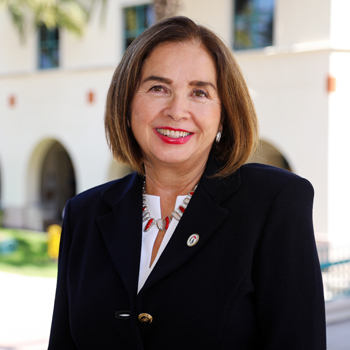
Adela de la Torre
San Diego State President
As one of a small number of Latinx university presidents in the U.S., what motivated you to keep pursuing new and higher roles when you didn’t see people like yourself in leadership positions?
I had so much support and encouragement from my grandmother, an immigrant from Mexico, and my mother, a public school teacher of 40 years. They were also big supporters of education. When I was a student, discrimination and bias were very present, so being motivated meant having not only desire, but also resilience and grit. In graduate school, I was part of a small group of Latina Ph.D. students who shared those qualities, and we supported each other. We called ourselves "Mujeres en Marcha," which translates to "Women on the Move," and we ended up graduating and becoming highly successful, most of us as faculty in higher education.
As my career matured and I earned leadership roles in universities, my motivation shifted from focusing on teaching and research on Latinx social inequalities to creating systemic change to address these inequalities. As president of SDSU, I have a unique opportunity to put into practice strategic initiatives and policies to further support access, equity and student success for current and future generations of students, faculty and staff. If that doesn't motivate you, I'm not sure what could.
How do your unique Latinx heritage and your lived experiences shape your leadership style?
In my experience and in my own family, I have found the Latinx community to be passionate, tenacious and family-focused. That heritage has served me well. My
familia supported me every step of my way to this position, and now, as president of this great university, I'm focused on growing the family atmosphere among our nearly 7,000 faculty and staff, 36,000 students and 470,000 alumni. The more we come together and support one another, the more SDSU will positively impact the world.
As a Latina undergraduate and graduate student, I was always passionate about
understanding social inequality and how to create a society that would bring everybody to the table to bridge these differences. I studied economics because it allowed me to understand the key factors that created barriers or opportunities for these types of conversations. Indeed, early on as an undergraduate I realized that Latinx economists were virtually nonexistent in these important discussions.
This lack of presence in the profession and dire need for the Latinx perspective on these issues propelled my desire to become the first Mexican American woman to earn a Ph.D. in agricultural and resource economics at University of California, Berkeley. As a leader, that kind of passion, self-awareness and focus for what you want to do is critical in order to be successful in these leadership roles. Not only do you achieve more, but it also drowns out the hostile and negative elements around you. I strive to impart that kind of passion and family spirit at SDSU.
How do you use your leadership platform as one of the few Latinx university presidents to inspire and empower students, faculty and staff to dream big and pursue their goals? What inspires you to do this important work day in and day out?
I want our students, faculty and staff at SDSU—no matter their race, ethnicity, gender or any other identity—to see me as a Latina in this role and realize that they, too, can be pioneers in their chosen fields. Leaders who break "traditional" molds are good reminders that there are pathways for others and that anything is possible. Inspiring someone to say, "I can do that," is a great first step in getting them to dream big. From there, I always try to bring people in and listen, to value their perspectives and to see how our goals and visions can align.
Giving them a voice and earning their support is empowering for them and makes me a more effective leader. And, ultimately, as SDSU president, I can support those big dreams by working to ensure there is a clarity of purpose that supports the expansion of access and opportunities for all students at SDSU and beyond. SDSU is now 125 years old and has come so far, but our work is not done and the opportunities for us are endless. That's what inspires me each and every day.